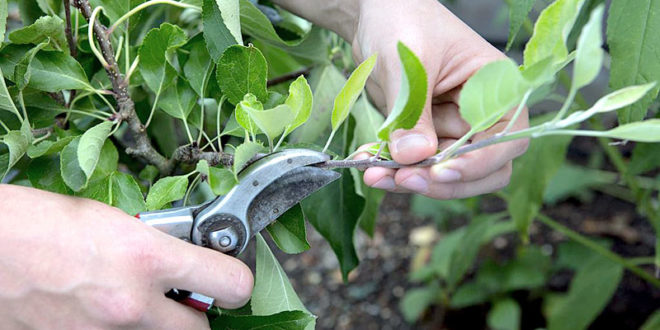You can remove dead, dying, or broken branches as soon as you notice them, but when it comes to pruning for shape or size, we recommended following these guidelines:
Early Spring: Prune summer-flowering trees and shrubs that bloom on the current season’s growth (new wood). This includes panicle hydrangea, rose-of-Sharon, summersweet (Clethra spp.), bush honeysuckle (Diervilla spp.), and Japanese spirea. Pruning in early spring allows these shrubs to focus their growth on the newly cut areas and prevents you from removing any stems that might have produced flowers.Early Spring: Prune evergreen shrubs or hedges in the spring before new growth emerges. Plants that are used in formal hedges and foundation plantings such as yew and privet can be trimmed with hedge shears to shape and to spur new growth. Arborvitae (Thuja spp.), juniper (Juniperus spp.), and boxwood (Buxus spp.) are other examples. Trim evergreen shrubs like junipers from the bottom up. Shorten branches that are expanding beyond the desired length by cutting them back to a lower branch beneath an overhanging branch. This provides a cleaner look, with the cuts hidden by the branches above.
Early spring: Prune pines and spruce if needed to control size. Prune pines by snapping off the ends of the new growth ″candles″ before the needles begin to expand. Trim one-third to one-half of the candles to form a fairly dense tree. If you need to severely restrict the current year’s growth, some of the candles can be completely removed at their base. For denser growth, prune spruce by cutting back the long tip of new growth just above the point where the side shoots are forming.Early spring: For most fruit-bearing trees and shrubs, the earlier the better. Pruning can be done any time temperatures are above twenty degrees and before spring growth starts. Prune fruit trees to open up the interior, which will allow more light to reach into the crown and promote better fruit production. Pruning methods vary by kind of fruit tree grown. There are even some differences for particular cultivars within a species. Check with your local nursery, garden center, or extension agent for detailed instructions.Spring: Clean up roses by cutting out all wood that died over the winter. Cut canes back to healthy, live wood just above an outward-facing bud. Then prune to shape the bush and achieve the desired height.After Spring: Wait to prune spring-flowering shrubs that bloom on last season’s growth (old wood) until AFTER they are done flowering. If you wait to prune until too long after blooming, you will be removing stems that would have produced flowers next spring. Woody plants that bloom on old wood include rhododendrons (Rhododendron spp.), dogwoods (Cornus spp.), lilacs (Syringa spp.), forsythia (Forsythia spp.), and some hydrangeas (Hydrangea macrophylla, H. quercifolia).When it comes to young deciduous trees, be very judicious if you prune. Remove crossing or rubbing branches, along with ones that are growing at an angle of thirty degrees or less relative to the trunk, as they are weakly joined and more likely to break off in storms. Remove branches that are growing closer to the ground than you would like once they reach about an inch in diameter. Leaving these branches in place when they are smaller than an inch in diameter will result in better root development and a sturdier trunk. Cut back branches to their point origin at the trunk or a lower branch; don’t leave stubs. Small twigs can be cut back to a bud to encourage more branching.
